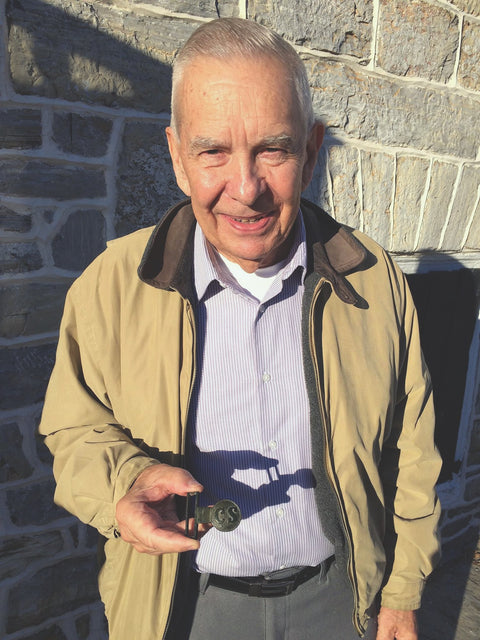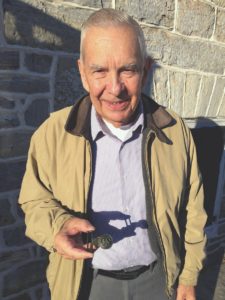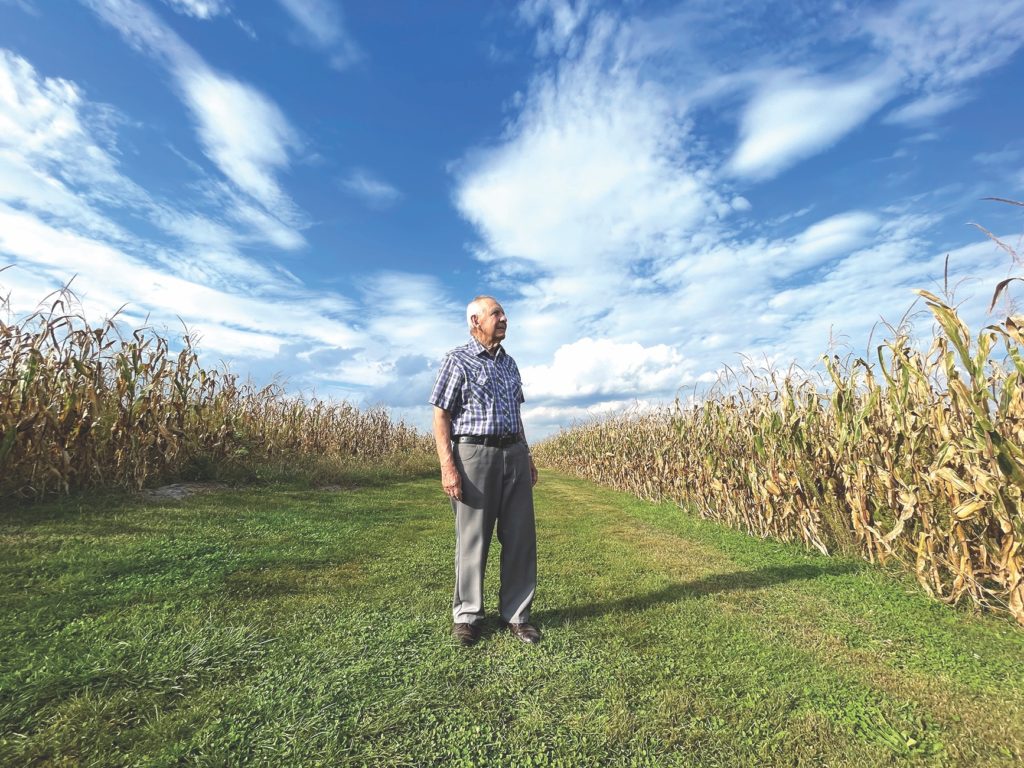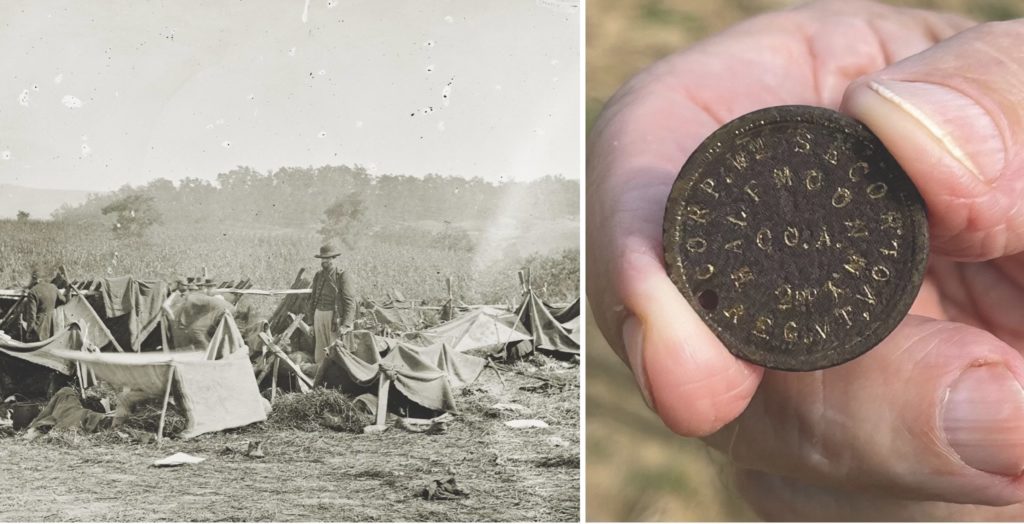
He’s Spent Decades Wandering Antietam — Here’s What He’s Found

On a baby-blue sky fall afternoon, Richard Clem and I stand among the remains of cornstalks in a field on the old Otho J. Smith Farm near the Antietam battleground. The South Mountain range stretches across the horizon to the east; roughly 350 yards away stand large, modern farm buildings. A hint of cow manure wafts through the air.
Clem, a wiry octogenarian with a soft, deep voice, quickly shifts into storytelling mode…and I love it.
“John, I remember coming out here relic hunting, and when the sunlight hit the field just right, you could see the glass glistening from the broken medicine bottles from that hospital.”
“Mr. Smith’s barn stood in the hollow out there. This hospital site was a mystery for many years.”
“Right over here on this hill I found that ID disc of that VER-mont soldier.”
A decade ago, I connected with Clem—a retired wood worker and lifelong Washington County, Md., resident—for a story about a Connecticut soldier who was killed by friendly fire at William Roulette’s farm at Antietam on September 17, 1862. We became fast friends, and no visit to Sharpsburg, Md., is complete for me now without exploring area historic sites with him or listening to Clem’s battlefield stories on his back porch.

I won’t forget the afternoon we examined the ruins of prewar kilns along the bank of the Potomac River at Shepherdstown, W.Va. (formerly Virginia), where friendly artillery fire killed 118th Pennsylvania soldiers on September 20, 1862.
“You’re an old man,” his delightful wife Gloria kidded him before our trek that day. “Watch yourself out there.” But Clem navigated the hills with the enthusiasm of a 22-year-old history geek.
I also won’t forget the day we visited the grave of Nancy Campbell, once enslaved by Roulette—the man who farmed one of Antietam’s most infamous killing fields. Or the day we spent in the “Corner of Death” on David R. Miller’s farm, when five battlefield trampers marveled as Clem told them stories.
Or after a lunch at Captain Bender’s Tavern in Sharpsburg, when the ever-generous Clem handed me a gift of four bullets and a Union coat button that he had eyeballed on the surface of the ground in the Bloody Cornfield in the late 1960s and early 1970s.
Shortly after my return home from that visit, an all-caps e-mail from Clem arrived in my in-box. Our visit, he wrote, was “A TIME I’LL LONG REMEMBER.”
GET HISTORY’S GREATEST TALES—RIGHT IN YOUR INBOX
Subscribe to our Historynet Now! newsletter for the best of the past, delivered every Wednesday.
In the late 1940s, Richard Clem’s grandmother Betty—then in her 60s—fueled his interest in the Civil War. On Sunday afternoons, his father pumped 50 cents’ worth of gas into an ancient Ford for excursions with the family from Hagerstown to the Antietam battlefield. Grandma packed a container with sardines, crackers, cheese, and water for the trips. Mom sat up front while Grandma sat in the back with Richard, whom she fondly called “Dickie.”
While Dad drove over gravel battlefield roads and across Burnside Bridge, then open to vehicles, Grandma fed Clem a steady diet of local history—the lifelong western Maryland resident knew people who had lived through the battle. She even recalled Civil War veterans visiting Sharpsburg.
“Dickie,” Grandma said during a battlefield trip, “that’s the old Iney Swain home there, and she told me back when she was still alive that there were wounded soldiers in her barn from the state of Massachusetts.”
At Bloody Lane, where the family ate lunch, Grandma recounted what locals had told her about the battle. “Even months after the battle, people would slip here on pools of dried blood,” she’d tell Dickie. Sometimes the truth may have been stretched a bit.
On the return trip to Hagerstown on the Sharpsburg Pike, the Clems passed the site of Dunker Church, the iconic battlefield landmark that had collapsed in a windstorm in April 1921. Only a pile of bricks from the original church remained. Clem remembers when it was the site of a gas station and a convenience store that sold ice cream, beer, and sandwiches. In the early 1960s, the church was rebuilt on the site with many of the original bricks.
“Grandmother didn’t understand exactly what happened during the Civil War,” Clem says, “but she knew and spoke almost like it was reverent to her. Sometimes she’d even tear up.”
Years later, Clem and his brother Don discovered the joys of hunting for battlefield relics. Most of the battlefield was in private hands then. So, on afternoons after work, Clem rode in his brother’s four-wheel drive jeep to Antietam, where they would eyeball relics in the fields—with a farmer’s permission, of course.
On the surface, just south of Bloody Lane, Clem found his first bullet—a fired, Union three-ringer. He still has it. “If you found four or five bullets, that was a good afternoon,” Clem recalls about those early hunts. After a hard rain in the 1960s, he eyeballed 18 bullets behind Dunker Church.

Later, the Clem brothers discovered the joys of hunting for artifacts with metal detectors. Their hobby turned into an obsession. On leisurely walks with Gloria, Clem often stared at the ground, fixated on what Civil War-era metal might lie beneath the surface.
Over the years, the brothers unearthed roughly 30,000 bullets and other artifacts in Maryland, Virginia, West Virginia, and Pennsylvania. Years later, they sold more than 12,000 of those bullets to artifact dealers for a buck apiece. Clem gave many away.
But these hunts were never business for Clem, who hung up his metal detector for good several years ago. In a notebook, he documented many of the artifacts recovered, noting their location and other details. For Cracker Barrel and Gettysburg magazines and The Washington Times, Clem wrote deeply researched stories about his most remarkable finds. And he continues to share his vast local historical knowledge with others.
Most of Clem’s relic hunts were a short distance from his Hagerstown home in Washington County, where brigades of soldiers in both armies fought and camped from 1861-65. Thousands of bullets and other artifacts turned up in U.S. Army 6th Corps camp sites in a farm field across the road from his house. In his backyard, Clem unearthed his first U.S. box plate and 50-60 bullets.
At the Otho Smith Farm, Clem and I walk steps from where Alexander Gardner set up his camera in September 1862 for a series of remarkable photographs. Here, at the division hospital for U.S. Army Maj. Gen. William French, doctors, volunteers, and others cared for hundreds of Antietam wounded from both sides.
Two images Gardner shot on the farm intrigue me most. In a cropped enlargement of one, an unidentified man—undoubtedly a wounded soldier—rests in a makeshift, hay-covered tent. Another shows 14th Indiana regimental surgeon Anson Hurd standing among wounded.
Clem and I often wonder about the heart-rending scenes that played out here.
“Almost every hour I witnessed the going out of some young life,” recalled nurse Elizabeth Harris about her service on the farm.
On the brink of death, a blue-eyed soldier—a “mere youth” with a “full, round face”—captured Harris’ heart. “Hold my hand till I die,” he told her. “I am trying to think of my Saviour; but think of my mother and father; their hearts will break.”
On a beautiful, fall day on the Smith Farm in 1991, Clem unearthed a brass identification disc—roughly the size of a quarter—under five inches of earth on a cedar-covered ridge. The rare find turned into an obsession for Clem, who has recovered three other soldier ID discs while relic hunting—a feat equivalent to Babe Ruth hitting four grand slams in a game.
Dog tags weren’t issued to Civil War soldiers; instead, they purchased their own “tags” in which they had their names and units stamped. No soldier wanted to be forgotten if he fell in battle or from disease. Letters, diaries, photographs, and ID discs often aided burial crews in the identification of soldier remains.
Clem’s dogged research brought the owner of the Smith Farm disc back to life. It belonged to 2nd Vermont color-bearer William Secor, a corporal, and the only soldier in his regiment to die at Antietam. Perhaps he was one of Harris’ patients.
Using a small hammer and lettered dies, a sutler probably hammered Secor’s name and regiment into the gold-plated disc. It may have cost the soldier 25 cents for a pair—one for him, another to send home.
Secor stood 5-foot-6¼, with blue eyes and brown hair. From Halfmoon, N.Y., he enlisted in neighboring Vermont. He was 21 and unmarried. On September 17, 1862, Secor was mortally wounded at Bloody Lane—an old sunken, country road during the battle and where the Clems picnicked decades later.
A condolence letter Clem discovered from Secor’s commanding officer to his stepfather shed further light on his last day on Earth.
“I saw the Chaplain that was with him in his last hours, and he said that it might be of consolation to his friends to know that he lived with a hope in Christ and was resigned to his fate,” Lieutenant Eugene O. Cole wrote. “As a soldier, there was none better.”
Clem believes U.S. Army comrades transported Secor to the Smith Farm along with countless other casualties. He likely was buried on the ridge with others. Perhaps their remains still rest there. Secor’s ID disc may have fallen out when his remains were disinterred for reburial in New York.
Before our visit to the farm ends, Clem pulls from his pocket the small disc. And so an Antietam story comes full circle. I am half-tempted to send Clem my own all-caps e-mail:
WE’RE GRATEFUL, RICHARD, THAT YOU KEEP HISTORY ALIVE. Ο

